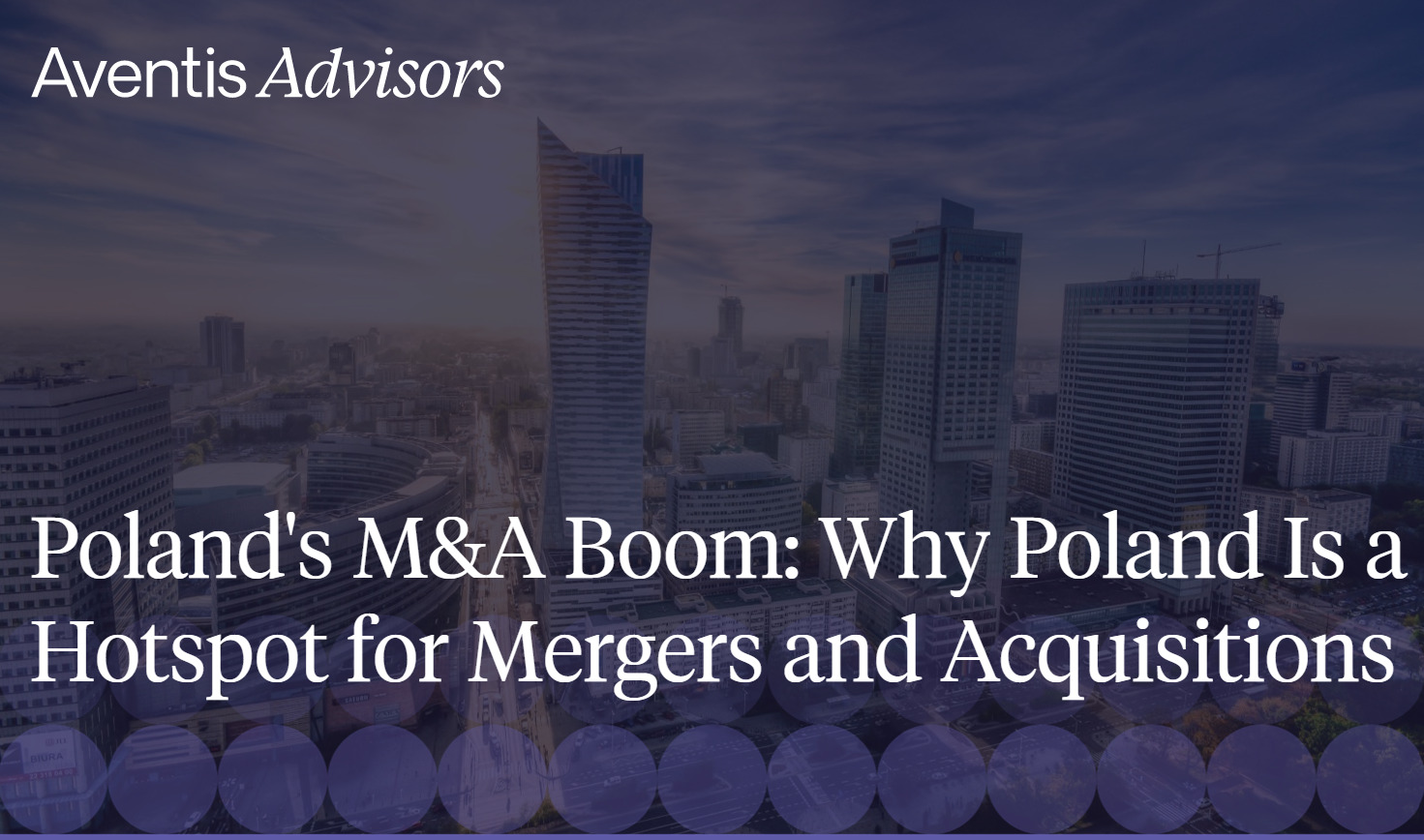Central and Eastern Europe (CEE) has been a growing hotspot for mergers and acquisitions (M&A) over the past two decades. Entering a fast-growing market, employing skilled and low-cost workforce, accessing other European Union (EU) member countries, and a supportive business environment are among the many benefits the region offers. We expect this strong positive momentum in M&A activity to persist as the economies of CEE continue to grow, and new investment opportunities arise.
This report entails an in-depth study of the underlying trends in the M&A landscape of CEE at a regional and country level. We analyze the median deal value and valuation multiples in M&A transactions in CEE and the rest of Europe and highlight the “CEE discount.” Lastly, the report sheds light on economic metrics, such as population, GDP and labor costs, that incentivize foreign buyers to expand in the region.
Our analysis covers the Central and Eastern European countries that are part of the European Union. The countries included in our analysis are Bulgaria, Croatia, the Czech Republic (also known as Czechia), Estonia, Hungary, Latvia, Lithuania, Poland, Romania, Slovakia, and Slovenia.
Table of Contents
I. Mergers and Acquisitions in CEE: Trends and Insights
III. Attractive Features of Central and Eastern Europe’s Economy
IV. Benefits of Partnering With a Local M&A Advisor
Mergers and Acquisitions in CEE: Trends and Insights
Total annual deal volumes are up 6x from what they were 21 years ago
Over two decades, from 2003 to 2024, the CEE region experienced a remarkable six-fold increase in M&A deals, skyrocketing from a modest 169 transactions to an impressive 1,074. While the 9.2% CAGR over the 21 years is outstanding, it’s worth noting that this growth wasn’t uniform throughout the entire period.
Following a solid start in the early years, deal flows declined by 43% between 2007 to 2009 as a result of the Global Financial Crises. We saw a strong bounce back in 2010 as global financial conditions improved. However, further growth in the early years of the new decade was muted by the European sovereign debt crises that weighed on consumer and business confidence across the continent.
In 2013, the total deal volumes reached a new record high at 737 and hovered around this level until 2021. In 2021, the risk-on environment pushed deal volumes to unprecedented levels. Despite the growing headwinds in 2022, notably Russia’s invasion of Ukraine and double-digit inflation, the M&A activity in CEE remained resilient, recording a record 1,245 deals over the year. In 2023 and 2024, deal volumes remained stable at around 1,100, significantly exceeding the median of 700 deals per year over the observed period.
Poland emerges as an M&A powerhouse, accounting for 1/3 of total deal volumes
Out of the 11 countries included in this analysis, Poland was a clear winner regarding deal flows. It has the largest economy by far, with its Real GDP reaching $633.6 billion in 2023. Despite the massive size, Poland’s economy achieved remarkable growth over the years, far outpacing most countries in Western Europe. Among others, deal volume in Poland was buoyed by its diverse economy, large population (approx. 37 million), low-cost labor, and competitive talent pool.
Poland’s M&A Boom: Why Poland Is a Hotspot for Mergers and Acquisitions
In addition to Poland’s remarkable performance, M&A in the Czech Republic also exhibited a significant uptick in deal volume, fueled by a booming tech industry, a surging consumer sector, and a robust industrial landscape. Meanwhile, M&A in Romania contributed 11% to the total M&A in Central and Eastern Europe between 2003 and 2024, a promising sign for the nation’s fast-growing economy.
Foreign buyers flock to CEE for cross-border M&A opportunities
51% of deals are cross-border
Cross-border M&A activity in CEE has consistently outstripped domestic deals, barring a few exceptions. This trend can be attributed to foreign investors’ keen interest in the region, drawn by its growing economy, skilled and cost-effective labor pool, and reputation for pioneering technological innovations.
When looking at the individual countries, those with fewer total deal volumes generally have a higher percentage of cross-border deals (e.g., M&A deals in Bulgaria, Latvia, and Slovenia). Most of these countries have a smaller economy implying that fewer local players can undertake acquisitions.
Software and industrials are prime targets for foreign investment in CEE
The cross-border M&A transactions across industries were marked by remarkable diversity, with no single industry accounting for more than 10% of the overall transactions. Nevertheless, with 635 deals, software emerged as the frontrunner, closely trailed by industrials, which registered 543 deals. Given the fast-evolving technology hub in the region, we anticipate M&A in software to grow as a percentage of total in the future.
Buyers from the USA and Germany emerge as top players in CEE’s M&A market
The USA and Germany combined accounted for over 1/5 of all the cross border M&A deals taking place between 2003 to 2024 in Central and Eastern Europe. Buyers from these two countries were particularly interested in the software, industrials, financials, automotive, and retail industries. The appeal of cost-cutting opportunities is a driving force behind the USA and Western European-based buyers’ strategic decision to expand in CEE. As shown in more detail later in this report, the average hourly labor cost in most Western European countries in 2023 was at least two times higher than the CEE average.
Substantial strategic investments and vibrant private equity scene
Strategic investment emerges as the cornerstone of mergers and acquisitions in CEE. The dynamic economies in the region present a unique opportunity for local and foreign businesses seeking to expand through M&A.
In particular, countries like Poland, the Czech Republic, Estonia, and Lithuania are renowned for their robust tech capabilities, attracting buyers seeking top-notch technologies. Furthermore, several industries in this region are fragmented, offering strategic buyers a vast pool of potential targets.
Throughout most of the analyzed period, the percentage of financial acquisitions hovered in the 20% range for the region. Among financial investors, private equity firms are the most active. The market hype in late 2020 and 2021 catalyzed a surge in private equity and venture capital firms’ activities, attracting unprecedented inflows and resulting in a spike in financial acquisitions. In 2022, the percentage of financial acquirers fell to 22% of deal volumes, driven by higher uncertainty and rising interest rates, which dampened private equity activity. In 2023, the percentage of financial buyers increased to 27%, likely due to a stabilizing environment and improved visibility into future interest rates
M&A in Estonia and M&A in Lithuania stand out on a country level, with the highest proportion of financial acquisitions among all CEE countries. Their dynamic tech ecosystems, which have been a magnet for private equity and venture capital firms, have significantly driven these results. M&A in the Czech Republic and M&A in Latvia involving a financial investor was also relatively high at ~23%. On the other hand, M&A in Croatia recorded the lowest activity on this front.
A wide range of sectors seeing strong M&A interest
The thriving technology landscape in Central and Eastern Europe has been a significant driver for local and international buyers seeking regional investment opportunities. Tech-focused mergers and acquisitions deals made up a substantial portion of the total transactions in CEE, accounting for 17.7% overall. M&A in Estonia, Lithuania, and Bulgaria saw an even higher proportion of tech-related deals, at around 25%.
While tech-related deals received significant attention, other sectors have also performed strongly in the CEE’s M&A landscape. The consumer sector, encompassing retail, food, and other consumer-related activities, accounted for 14.6% of total transactions. M&A in Slovenia, Croatia, and Latvia were particularly active in these markets. We also observed robust momentum in the region’s financials, industrials, and energy sectors.
CEE’s booming tech M&A scene
The tech industry has been at the forefront of M&A activity in Central and Eastern Europe, accounting for around 17% of all the regional deals between 2003 to 2024. For most analyzed countries, it was the leading sector in deal volumes, particularly for Estonia, Bulgaria, and Lithuania when looking at percentages. In absolute terms, Poland emerged as a dominant force with a whopping 803 tech deals, followed closely by the M&A in the Czech Republic (411 deals) and M&A in Romania (266 deals).
M&A Transaction Analysis
In this section, we will analyze the deal value and valuation multiples used in M&A transactions of CEE versus the rest of Europe. Not all deals have disclosed financials, and in smaller countries in particular, it’s likely that only deals with the highest total transaction value report deal value. Therefore, our analysis refrains from examining the total deal value. Instead, we concentrated on the median figures, as this allows for a better comparison between the two regions.
Median deal value: CEE vs. the rest of Europe
From 2003 to 2024, the CEE region consistently saw lower median deal values than the rest of Europe, except for a brief period in 2010 and 2011. From 2006 to 2013, both areas experienced a decrease in their median deal values. The primary catalyst for this trend was the 2008 Great Financial Crisis, followed by the subsequent European sovereign debt crises. Another major factor contributing to the decreasing deal value is the growing number of deals involving smaller firms being acquired and consolidated by private equity, which is putting downward pressure on the median value
Starting in 2014, there was a short-lived period where the median deal size for the CEE and the rest of Europe experienced a growth trajectory. However, this growth was not sustained, and the median deal sizes declined after that. In 2020, both groups hit their lowest median deal sizes; EUR 7.8m for CEE and EUR 10.0m for the rest of Europe, respectively.
In 2021, deal sizes rebounded as economic conditions improved, with median values in the CEE and Europe nearly doubling over the next year. Despite increasing headwinds, this upward trend continued in 2022. During this time, financial investors held record levels of dry powder, and PE-backed strategics were well-positioned to compete for high-value targets, pushing deal values higher to record levels.
Median EBITDA multiple: CEE vs. the rest of Europe
The median EBITDA multiple used in M&A transactions in the CEE region was lower than that of the rest of Europe for most of 2003 to 2023. We saw considerable volatility during recessionary periods in 2008 and early 2020. In 2021, the median EBITDA multiple almost doubled to 11.7x, but it fell to 5.8x in 2022. In 2023, the median EBITDA multiple in CEE recovered to 8.7x and subsequently rose to 10.5x in 2024, surpassing the European average.
To gain a deeper understanding of long-term trends and mitigate the effect of short-term volatility, we have incorporated the 3-year moving average for CEE’s median EBITDA multiple. By comparing it to the median EBITDA multiple for the rest of Europe, we observe a discernible trend of an expanding CEE discount developing until 2022. The discount reached its widest spread in 2022, with the EBITDA multiple in the rest of Europe at 13.0x, while the multiple in Central and Eastern Europe (CEE) dropped to a historically low 5.8x, resulting in a spread of 7.2x. By 2023, this spread was nearly eliminated as the median EBITDA multiples in the rest of Europe fell from 13.0x to 9.2x. This decline in the rest of Europe, down to historical averages of 10.1x, was primarily driven by shifting investor sentiment and ongoing macroeconomic uncertainty.
The CEE discount has historically resulted from several factors, including smaller deal sizes, less intense buyer competition, and more significant market fragmentation. Moreover, elevated political and economic risks in certain countries have also contributed to this discount. Finally, it’s worth noting that several CEE nations have higher equity risk premiums, which are utilized for discounting future cash flows, ultimately leading to lower valuations.
Revenue EBITDA multiple: CEE vs. the rest of Europe
The median revenue multiple in M&A deals within Central and Eastern Europe demonstrated a notably higher degree of fluctuation than in other regions of Europe. This was particularly evident between 2020 to 2021, when it doubled to 1.6x. However, while the median revenue multiple continued to rise gradually in other parts of Europe in 2022, within the CEE region, it experienced a decline, dropping to 1.0x. In 2023. the multiple stabilized around 1.0x, and expanded in 2024 to 1.4x revenue.
Applying the 3-year moving average to smooth out short-term fluctuations, we see a growing discount between targets based in CEE vs. the rest of Europe. This trend, akin to the EBITDA multiple, results from smaller deal sizes and competition among buyers, market fragmentation, higher political and economic risks, and higher discount rates. In 2023, this discount abruptly compressed, mainly due to a steep drop in multiples paid in other European transactions.
Attractive Features of Central and Eastern Europe’s Economy
(2023 data show, 2024 data currently unavailable)
The CEE region has become a compelling economic destination for businesses seeking to tap into domestic and international markets. With its diversified economy and strong growth potential, CEE offers a highly skilled workforce at a low cost, favorable demographic trends, and substantial foreign direct investment. Moreover, the region’s growing integration with global markets and its emphasis on innovation and digitalization positions CEE as a critical player in the global economy.
In the following sections, we take a deeper look into two vital macroeconomic variables; GDP and labor cost.
Real GDP grew at a 3% CAGR between 2003 to 2023
Over the last two decades, the Central and Eastern European region has experienced remarkable economic growth, with its average Real GDP growth significantly outpacing the European Union’s average. This impressive performance can be attributed to several factors, including a robust demand underpinned by the growing number of middle-income consumers, a highly skilled workforce, and attractive investment incentives. As a result, the region has become a hotbed of mergers and acquisitions activity, with foreign buyers keen to tap into the high growth rates and favorable business environment.
Growing workforce available for ⅓ wages in Western Europe
Another key factor why the M&A activity in the CEE region rose over the years is the relatively low labor cost, which is half the EU average. The region’s highly skilled workforce and lower wage costs provide an attractive proposition for foreign investors looking to enter the market. This combination of skilled labor and lower costs has made the region a preferred destination for companies looking to establish their foothold in Europe or expand their existing operations.
Aventis Advisors Will Help You Navigate the CEE M&A Landscape
The growing number of deals in Central and Eastern Europe has raised the demand for M&A advisors based in this region. By partnering with an M&A advisor in CEE, you can gain valuable insights into the rising countries, industries, and companies that could be ideal matches for your business. The expertise of local M&A advisors is particularly beneficial in cross-border transactions. They can help foreign parties understand the market dynamics and legal and regulatory framework and overcome language and cultural barriers.
At Aventis Advisors, we have accumulated extensive expertise in assisting international buyers with the unique complexities of investing in CEE. With our access to local databases and networks, we can provide valuable insights and support in selecting and closing the right deal for you. Our experience connecting foreign investors with CEE-based targets enables us to handle all your investment needs, from navigating complex financial requirements to bridging cultural gaps.
About Aventis Advisors
Aventis Advisors is an M&A advisor for technology and growth companies, based in CEE. We believe the world would be better off with fewer (but better quality) M&A deals done at the right moment for the company and its owners. Our goal is to provide honest, insight-driven advice, clearly laying out all the options for our clients – including the one to keep the status quo.
Get in touch with us to discuss how much your business could be worth and how the process looks.




